Assessment 1 Written Questions: CHCDIV001 - Early Childhood Education
VerifiedAdded on 2023/01/03
|11
|3240
|31
Homework Assignment
AI Summary
This document presents a student's responses to the CHCDIV001 Assessment 1, focusing on underpinning knowledge related to working with diverse people in early childhood education and care. The assessment covers a range of topics, including relevant regulations from the Education and Care Services National Regulations, the role of food in cultural, social, and religious practices, and examples of planning and implementing cultural events. The student defines cultural awareness, identifies different aspects of cultural diversity, and describes the cultural diversity within their community. The assignment also addresses human rights, their importance, and ways to demonstrate respect for cultural diversity in the workplace, including strategies for addressing language barriers. The assessment aims to evaluate the student's understanding of key concepts related to cultural competence and inclusive practices in early childhood settings, ensuring they align with the Australian Qualification Framework level 3.

Assessment 1 Written Questions - Underpinning Knowledge Assessment
Student Details
Student First Name ㅡㅡ
Student Last Name
Trainer Name
Select Qualification: (Tick)
☐ CHC30113 Certificate III in Early Childhood Education and Care
☐ CHC50113 Diploma of Early Childhood Education and Care
MARKING SHEET - UNDERPINNING KNOWLEDGE
CHCDIV001 Work with diverse people
Questions S NS Comment
1
2
3
4
5
6
7
8
9
10
11
12
13
14
15
Assessment Sign-Off:
Result: (tick one)
Satisfactory Mark is 15/15
Satisfactory Not Satisfactory☐ ☐
Trainer Signature:
Date assessed:
Student Signature:
Date assessed:
Mark Transferred to Unit Summary Results: Yes / No
CHCDIV001 A1 Underpinning Knowledge - Student v20200330 (1).docx
Review Date: 27 Dec 2020 Page 1 of 11
CHCDIV001 Work with diverse people
Student Details
Student First Name ㅡㅡ
Student Last Name
Trainer Name
Select Qualification: (Tick)
☐ CHC30113 Certificate III in Early Childhood Education and Care
☐ CHC50113 Diploma of Early Childhood Education and Care
MARKING SHEET - UNDERPINNING KNOWLEDGE
CHCDIV001 Work with diverse people
Questions S NS Comment
1
2
3
4
5
6
7
8
9
10
11
12
13
14
15
Assessment Sign-Off:
Result: (tick one)
Satisfactory Mark is 15/15
Satisfactory Not Satisfactory☐ ☐
Trainer Signature:
Date assessed:
Student Signature:
Date assessed:
Mark Transferred to Unit Summary Results: Yes / No
CHCDIV001 A1 Underpinning Knowledge - Student v20200330 (1).docx
Review Date: 27 Dec 2020 Page 1 of 11
CHCDIV001 Work with diverse people
Paraphrase This Document
Need a fresh take? Get an instant paraphrase of this document with our AI Paraphraser
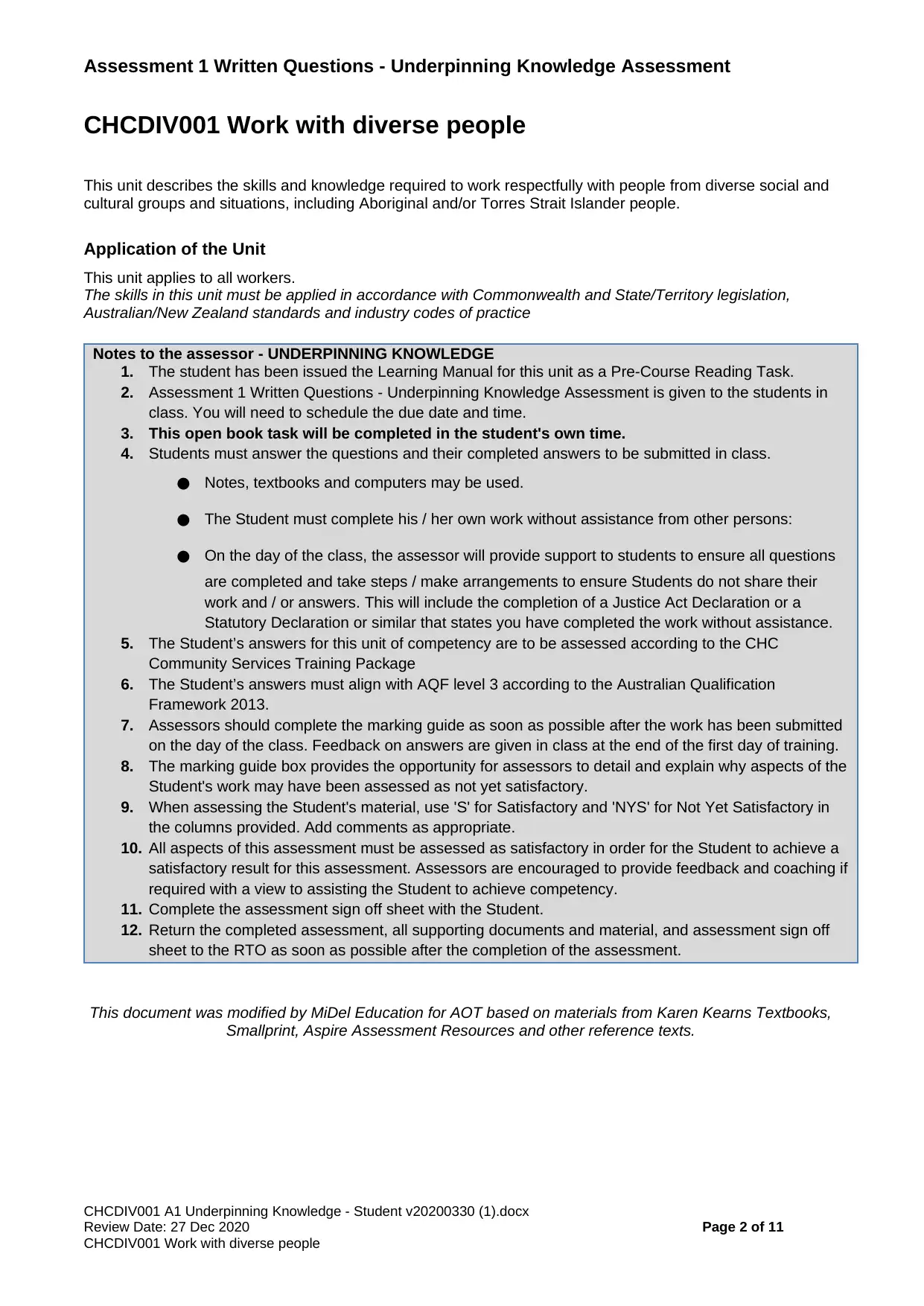
Assessment 1 Written Questions - Underpinning Knowledge Assessment
CHCDIV001 Work with diverse people
This unit describes the skills and knowledge required to work respectfully with people from diverse social and
cultural groups and situations, including Aboriginal and/or Torres Strait Islander people.
Application of the Unit
This unit applies to all workers.
The skills in this unit must be applied in accordance with Commonwealth and State/Territory legislation,
Australian/New Zealand standards and industry codes of practice
Notes to the assessor - UNDERPINNING KNOWLEDGE
1. The student has been issued the Learning Manual for this unit as a Pre-Course Reading Task.
2. Assessment 1 Written Questions - Underpinning Knowledge Assessment is given to the students in
class. You will need to schedule the due date and time.
3. This open book task will be completed in the student's own time.
4. Students must answer the questions and their completed answers to be submitted in class.
● Notes, textbooks and computers may be used.
● The Student must complete his / her own work without assistance from other persons:
● On the day of the class, the assessor will provide support to students to ensure all questions
are completed and take steps / make arrangements to ensure Students do not share their
work and / or answers. This will include the completion of a Justice Act Declaration or a
Statutory Declaration or similar that states you have completed the work without assistance.
5. The Student’s answers for this unit of competency are to be assessed according to the CHC
Community Services Training Package
6. The Student’s answers must align with AQF level 3 according to the Australian Qualification
Framework 2013.
7. Assessors should complete the marking guide as soon as possible after the work has been submitted
on the day of the class. Feedback on answers are given in class at the end of the first day of training.
8. The marking guide box provides the opportunity for assessors to detail and explain why aspects of the
Student's work may have been assessed as not yet satisfactory.
9. When assessing the Student's material, use 'S' for Satisfactory and 'NYS' for Not Yet Satisfactory in
the columns provided. Add comments as appropriate.
10. All aspects of this assessment must be assessed as satisfactory in order for the Student to achieve a
satisfactory result for this assessment. Assessors are encouraged to provide feedback and coaching if
required with a view to assisting the Student to achieve competency.
11. Complete the assessment sign off sheet with the Student.
12. Return the completed assessment, all supporting documents and material, and assessment sign off
sheet to the RTO as soon as possible after the completion of the assessment.
This document was modified by MiDel Education for AOT based on materials from Karen Kearns Textbooks,
Smallprint, Aspire Assessment Resources and other reference texts.
CHCDIV001 A1 Underpinning Knowledge - Student v20200330 (1).docx
Review Date: 27 Dec 2020 Page 2 of 11
CHCDIV001 Work with diverse people
CHCDIV001 Work with diverse people
This unit describes the skills and knowledge required to work respectfully with people from diverse social and
cultural groups and situations, including Aboriginal and/or Torres Strait Islander people.
Application of the Unit
This unit applies to all workers.
The skills in this unit must be applied in accordance with Commonwealth and State/Territory legislation,
Australian/New Zealand standards and industry codes of practice
Notes to the assessor - UNDERPINNING KNOWLEDGE
1. The student has been issued the Learning Manual for this unit as a Pre-Course Reading Task.
2. Assessment 1 Written Questions - Underpinning Knowledge Assessment is given to the students in
class. You will need to schedule the due date and time.
3. This open book task will be completed in the student's own time.
4. Students must answer the questions and their completed answers to be submitted in class.
● Notes, textbooks and computers may be used.
● The Student must complete his / her own work without assistance from other persons:
● On the day of the class, the assessor will provide support to students to ensure all questions
are completed and take steps / make arrangements to ensure Students do not share their
work and / or answers. This will include the completion of a Justice Act Declaration or a
Statutory Declaration or similar that states you have completed the work without assistance.
5. The Student’s answers for this unit of competency are to be assessed according to the CHC
Community Services Training Package
6. The Student’s answers must align with AQF level 3 according to the Australian Qualification
Framework 2013.
7. Assessors should complete the marking guide as soon as possible after the work has been submitted
on the day of the class. Feedback on answers are given in class at the end of the first day of training.
8. The marking guide box provides the opportunity for assessors to detail and explain why aspects of the
Student's work may have been assessed as not yet satisfactory.
9. When assessing the Student's material, use 'S' for Satisfactory and 'NYS' for Not Yet Satisfactory in
the columns provided. Add comments as appropriate.
10. All aspects of this assessment must be assessed as satisfactory in order for the Student to achieve a
satisfactory result for this assessment. Assessors are encouraged to provide feedback and coaching if
required with a view to assisting the Student to achieve competency.
11. Complete the assessment sign off sheet with the Student.
12. Return the completed assessment, all supporting documents and material, and assessment sign off
sheet to the RTO as soon as possible after the completion of the assessment.
This document was modified by MiDel Education for AOT based on materials from Karen Kearns Textbooks,
Smallprint, Aspire Assessment Resources and other reference texts.
CHCDIV001 A1 Underpinning Knowledge - Student v20200330 (1).docx
Review Date: 27 Dec 2020 Page 2 of 11
CHCDIV001 Work with diverse people
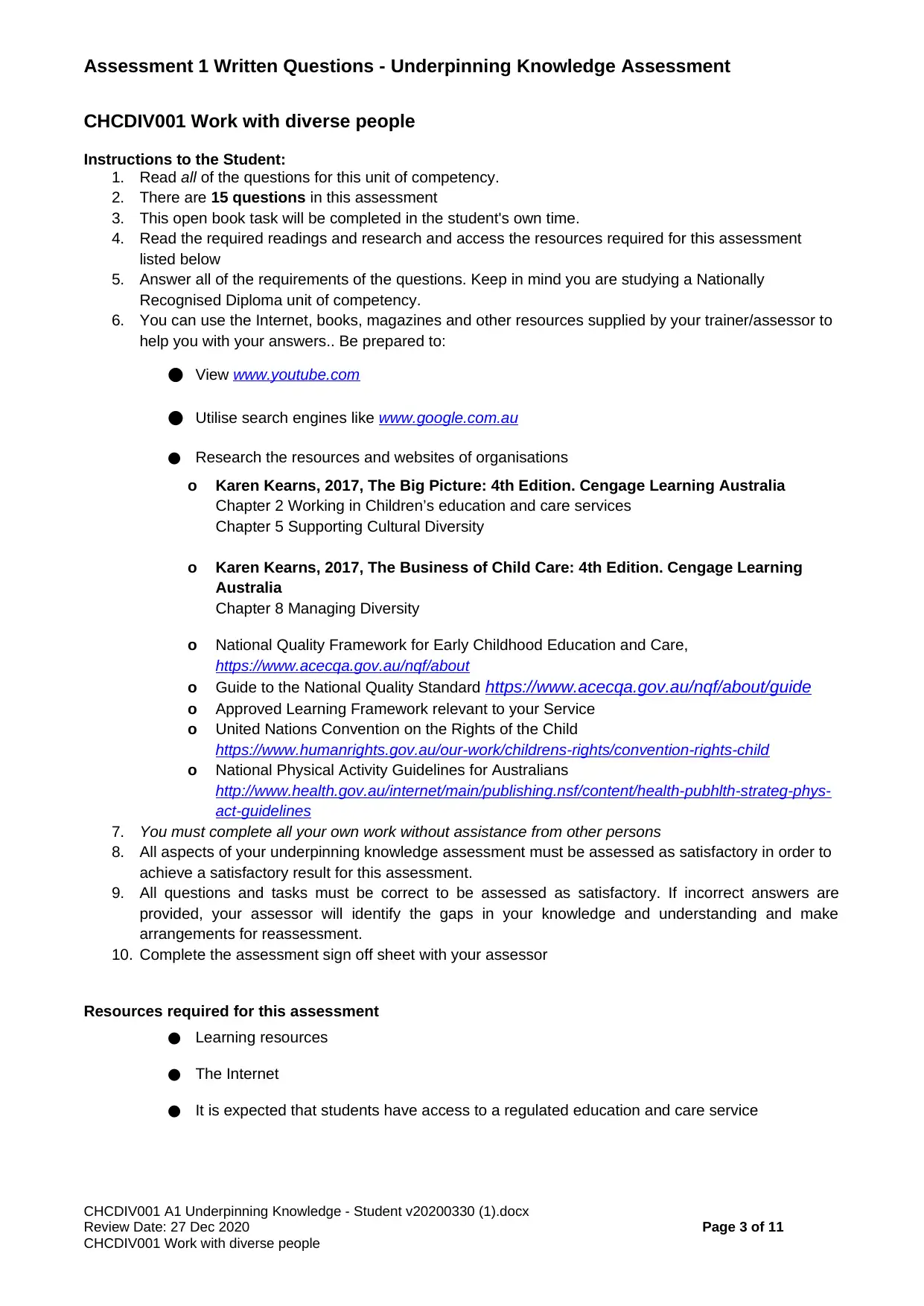
Assessment 1 Written Questions - Underpinning Knowledge Assessment
CHCDIV001 Work with diverse people
Instructions to the Student:
1. Read all of the questions for this unit of competency.
2. There are 15 questions in this assessment
3. This open book task will be completed in the student's own time.
4. Read the required readings and research and access the resources required for this assessment
listed below
5. Answer all of the requirements of the questions. Keep in mind you are studying a Nationally
Recognised Diploma unit of competency.
6. You can use the Internet, books, magazines and other resources supplied by your trainer/assessor to
help you with your answers.. Be prepared to:
● View www.youtube.com
● Utilise search engines like www.google.com.au
● Research the resources and websites of organisations
o Karen Kearns, 2017, The Big Picture: 4th Edition. Cengage Learning Australia
Chapter 2 Working in Children’s education and care services
Chapter 5 Supporting Cultural Diversity
o Karen Kearns, 2017, The Business of Child Care: 4th Edition. Cengage Learning
Australia
Chapter 8 Managing Diversity
o National Quality Framework for Early Childhood Education and Care,
https://www.acecqa.gov.au/nqf/about
o Guide to the National Quality Standard https://www.acecqa.gov.au/nqf/about/guide
o Approved Learning Framework relevant to your Service
o United Nations Convention on the Rights of the Child
https://www.humanrights.gov.au/our-work/childrens-rights/convention-rights-child
o National Physical Activity Guidelines for Australians
http://www.health.gov.au/internet/main/publishing.nsf/content/health-pubhlth-strateg-phys-
act-guidelines
7. You must complete all your own work without assistance from other persons
8. All aspects of your underpinning knowledge assessment must be assessed as satisfactory in order to
achieve a satisfactory result for this assessment.
9. All questions and tasks must be correct to be assessed as satisfactory. If incorrect answers are
provided, your assessor will identify the gaps in your knowledge and understanding and make
arrangements for reassessment.
10. Complete the assessment sign off sheet with your assessor
Resources required for this assessment
● Learning resources
● The Internet
● It is expected that students have access to a regulated education and care service
CHCDIV001 A1 Underpinning Knowledge - Student v20200330 (1).docx
Review Date: 27 Dec 2020 Page 3 of 11
CHCDIV001 Work with diverse people
CHCDIV001 Work with diverse people
Instructions to the Student:
1. Read all of the questions for this unit of competency.
2. There are 15 questions in this assessment
3. This open book task will be completed in the student's own time.
4. Read the required readings and research and access the resources required for this assessment
listed below
5. Answer all of the requirements of the questions. Keep in mind you are studying a Nationally
Recognised Diploma unit of competency.
6. You can use the Internet, books, magazines and other resources supplied by your trainer/assessor to
help you with your answers.. Be prepared to:
● View www.youtube.com
● Utilise search engines like www.google.com.au
● Research the resources and websites of organisations
o Karen Kearns, 2017, The Big Picture: 4th Edition. Cengage Learning Australia
Chapter 2 Working in Children’s education and care services
Chapter 5 Supporting Cultural Diversity
o Karen Kearns, 2017, The Business of Child Care: 4th Edition. Cengage Learning
Australia
Chapter 8 Managing Diversity
o National Quality Framework for Early Childhood Education and Care,
https://www.acecqa.gov.au/nqf/about
o Guide to the National Quality Standard https://www.acecqa.gov.au/nqf/about/guide
o Approved Learning Framework relevant to your Service
o United Nations Convention on the Rights of the Child
https://www.humanrights.gov.au/our-work/childrens-rights/convention-rights-child
o National Physical Activity Guidelines for Australians
http://www.health.gov.au/internet/main/publishing.nsf/content/health-pubhlth-strateg-phys-
act-guidelines
7. You must complete all your own work without assistance from other persons
8. All aspects of your underpinning knowledge assessment must be assessed as satisfactory in order to
achieve a satisfactory result for this assessment.
9. All questions and tasks must be correct to be assessed as satisfactory. If incorrect answers are
provided, your assessor will identify the gaps in your knowledge and understanding and make
arrangements for reassessment.
10. Complete the assessment sign off sheet with your assessor
Resources required for this assessment
● Learning resources
● The Internet
● It is expected that students have access to a regulated education and care service
CHCDIV001 A1 Underpinning Knowledge - Student v20200330 (1).docx
Review Date: 27 Dec 2020 Page 3 of 11
CHCDIV001 Work with diverse people
⊘ This is a preview!⊘
Do you want full access?
Subscribe today to unlock all pages.

Trusted by 1+ million students worldwide
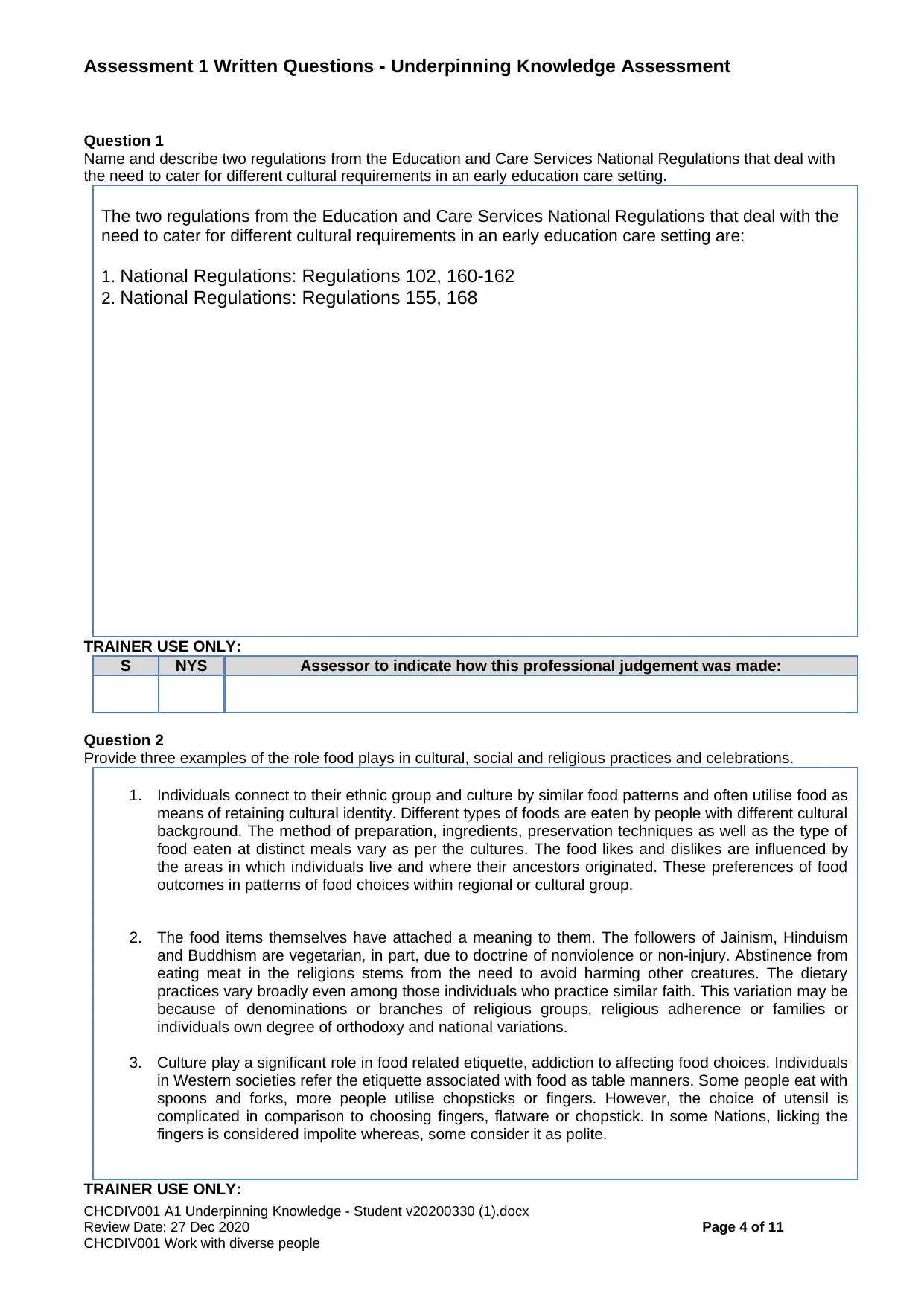
Assessment 1 Written Questions - Underpinning Knowledge Assessment
Question 1
Name and describe two regulations from the Education and Care Services National Regulations that deal with
the need to cater for different cultural requirements in an early education care setting.
The two regulations from the Education and Care Services National Regulations that deal with the
need to cater for different cultural requirements in an early education care setting are:
1. National Regulations: Regulations 102, 160-162
2. National Regulations: Regulations 155, 168
TRAINER USE ONLY:
S NYS Assessor to indicate how this professional judgement was made:
Question 2
Provide three examples of the role food plays in cultural, social and religious practices and celebrations.
1. Individuals connect to their ethnic group and culture by similar food patterns and often utilise food as
means of retaining cultural identity. Different types of foods are eaten by people with different cultural
background. The method of preparation, ingredients, preservation techniques as well as the type of
food eaten at distinct meals vary as per the cultures. The food likes and dislikes are influenced by
the areas in which individuals live and where their ancestors originated. These preferences of food
outcomes in patterns of food choices within regional or cultural group.
2. The food items themselves have attached a meaning to them. The followers of Jainism, Hinduism
and Buddhism are vegetarian, in part, due to doctrine of nonviolence or non-injury. Abstinence from
eating meat in the religions stems from the need to avoid harming other creatures. The dietary
practices vary broadly even among those individuals who practice similar faith. This variation may be
because of denominations or branches of religious groups, religious adherence or families or
individuals own degree of orthodoxy and national variations.
3. Culture play a significant role in food related etiquette, addiction to affecting food choices. Individuals
in Western societies refer the etiquette associated with food as table manners. Some people eat with
spoons and forks, more people utilise chopsticks or fingers. However, the choice of utensil is
complicated in comparison to choosing fingers, flatware or chopstick. In some Nations, licking the
fingers is considered impolite whereas, some consider it as polite.
TRAINER USE ONLY:
CHCDIV001 A1 Underpinning Knowledge - Student v20200330 (1).docx
Review Date: 27 Dec 2020 Page 4 of 11
CHCDIV001 Work with diverse people
Question 1
Name and describe two regulations from the Education and Care Services National Regulations that deal with
the need to cater for different cultural requirements in an early education care setting.
The two regulations from the Education and Care Services National Regulations that deal with the
need to cater for different cultural requirements in an early education care setting are:
1. National Regulations: Regulations 102, 160-162
2. National Regulations: Regulations 155, 168
TRAINER USE ONLY:
S NYS Assessor to indicate how this professional judgement was made:
Question 2
Provide three examples of the role food plays in cultural, social and religious practices and celebrations.
1. Individuals connect to their ethnic group and culture by similar food patterns and often utilise food as
means of retaining cultural identity. Different types of foods are eaten by people with different cultural
background. The method of preparation, ingredients, preservation techniques as well as the type of
food eaten at distinct meals vary as per the cultures. The food likes and dislikes are influenced by
the areas in which individuals live and where their ancestors originated. These preferences of food
outcomes in patterns of food choices within regional or cultural group.
2. The food items themselves have attached a meaning to them. The followers of Jainism, Hinduism
and Buddhism are vegetarian, in part, due to doctrine of nonviolence or non-injury. Abstinence from
eating meat in the religions stems from the need to avoid harming other creatures. The dietary
practices vary broadly even among those individuals who practice similar faith. This variation may be
because of denominations or branches of religious groups, religious adherence or families or
individuals own degree of orthodoxy and national variations.
3. Culture play a significant role in food related etiquette, addiction to affecting food choices. Individuals
in Western societies refer the etiquette associated with food as table manners. Some people eat with
spoons and forks, more people utilise chopsticks or fingers. However, the choice of utensil is
complicated in comparison to choosing fingers, flatware or chopstick. In some Nations, licking the
fingers is considered impolite whereas, some consider it as polite.
TRAINER USE ONLY:
CHCDIV001 A1 Underpinning Knowledge - Student v20200330 (1).docx
Review Date: 27 Dec 2020 Page 4 of 11
CHCDIV001 Work with diverse people
Paraphrase This Document
Need a fresh take? Get an instant paraphrase of this document with our AI Paraphraser
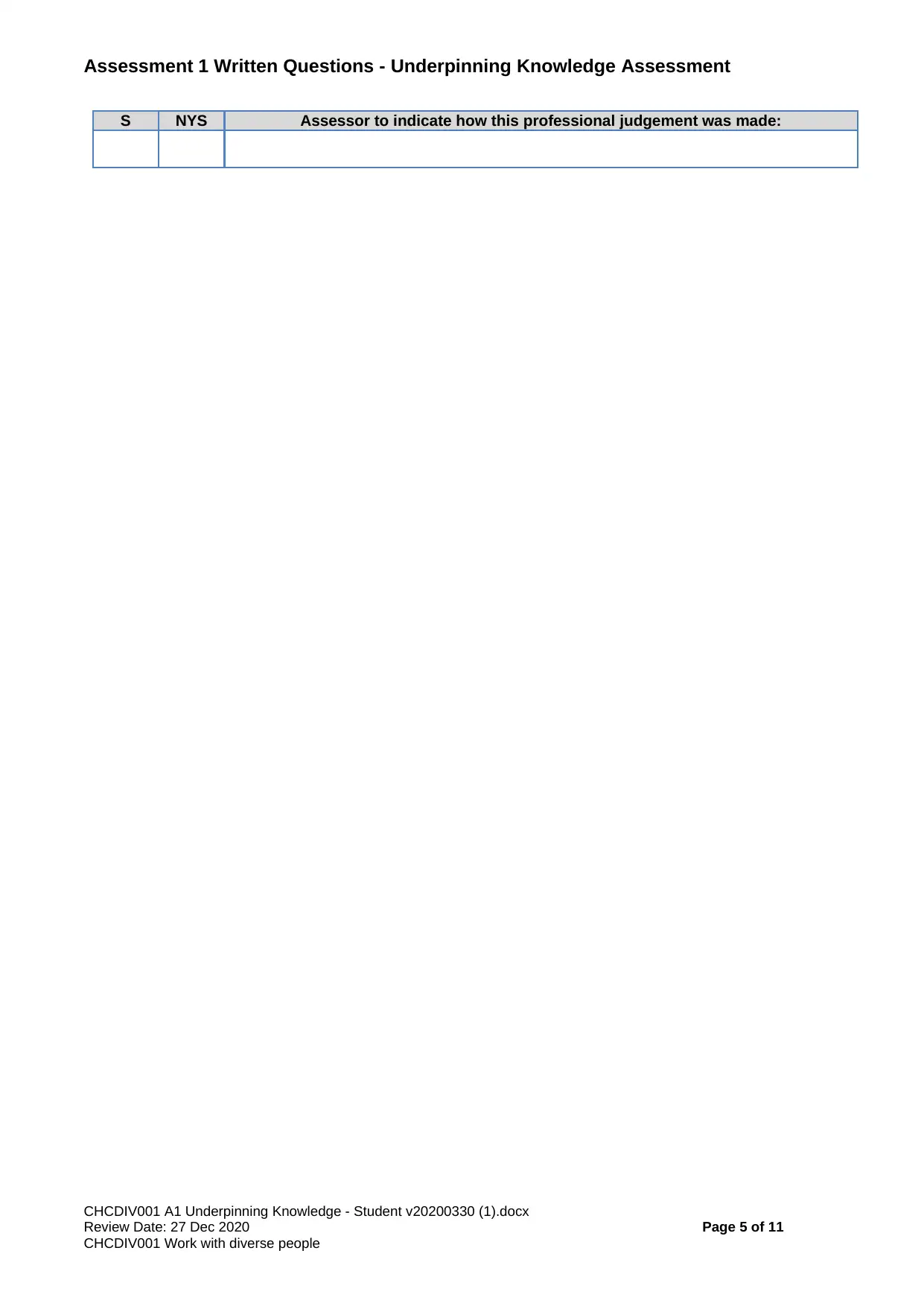
Assessment 1 Written Questions - Underpinning Knowledge Assessment
S NYS Assessor to indicate how this professional judgement was made:
CHCDIV001 A1 Underpinning Knowledge - Student v20200330 (1).docx
Review Date: 27 Dec 2020 Page 5 of 11
CHCDIV001 Work with diverse people
S NYS Assessor to indicate how this professional judgement was made:
CHCDIV001 A1 Underpinning Knowledge - Student v20200330 (1).docx
Review Date: 27 Dec 2020 Page 5 of 11
CHCDIV001 Work with diverse people
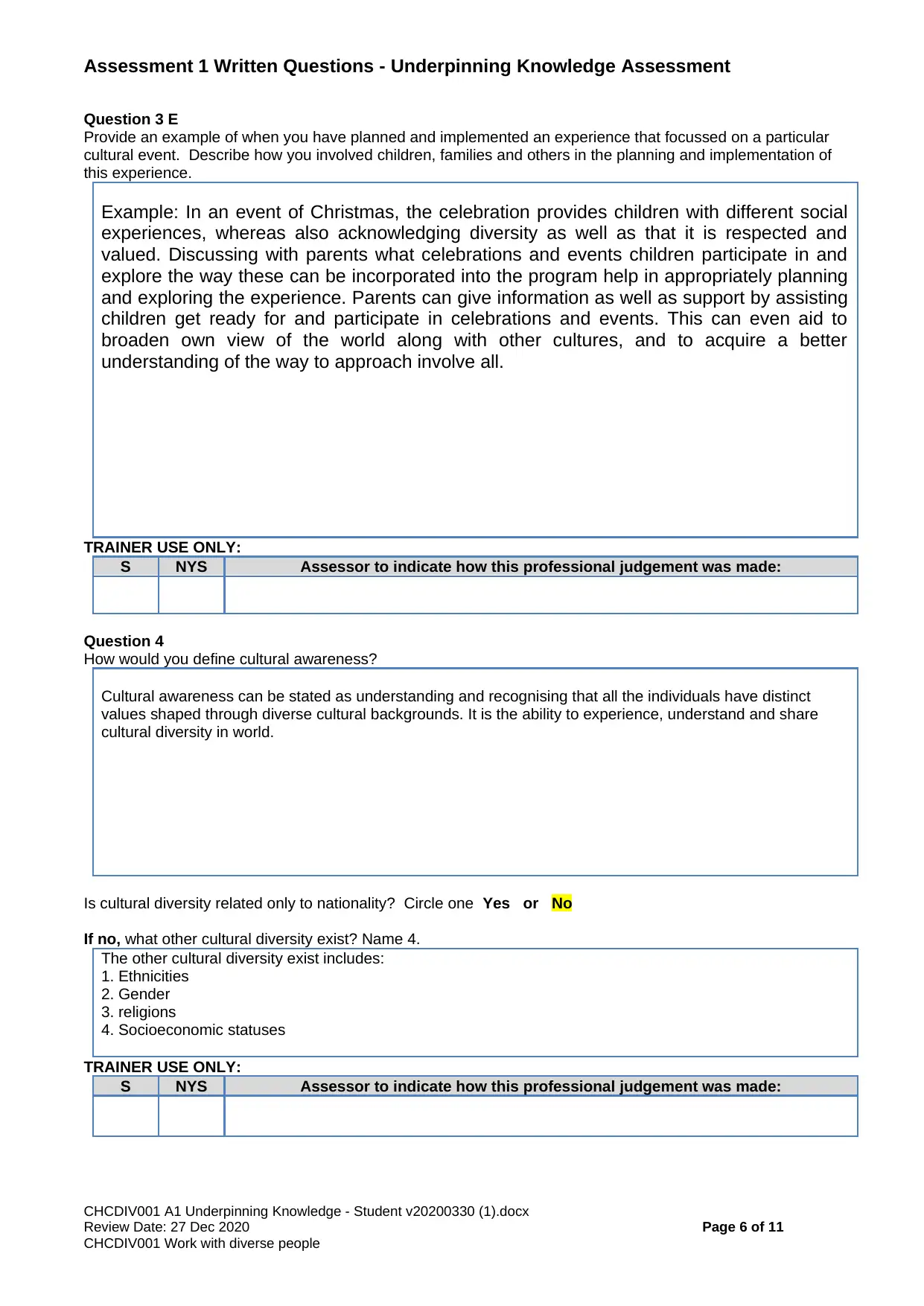
Assessment 1 Written Questions - Underpinning Knowledge Assessment
Question 3 E
Provide an example of when you have planned and implemented an experience that focussed on a particular
cultural event. Describe how you involved children, families and others in the planning and implementation of
this experience.
Example: In an event of Christmas, the celebration provides children with different social
experiences, whereas also acknowledging diversity as well as that it is respected and
valued. Discussing with parents what celebrations and events children participate in and
explore the way these can be incorporated into the program help in appropriately planning
and exploring the experience. Parents can give information as well as support by assisting
children get ready for and participate in celebrations and events. This can even aid to
broaden own view of the world along with other cultures, and to acquire a better
understanding of the way to approach involve all.
TRAINER USE ONLY:
S NYS Assessor to indicate how this professional judgement was made:
Question 4
How would you define cultural awareness?
Cultural awareness can be stated as understanding and recognising that all the individuals have distinct
values shaped through diverse cultural backgrounds. It is the ability to experience, understand and share
cultural diversity in world.
Is cultural diversity related only to nationality? Circle one Yes or No
If no, what other cultural diversity exist? Name 4.
The other cultural diversity exist includes:
1. Ethnicities
2. Gender
3. religions
4. Socioeconomic statuses
TRAINER USE ONLY:
S NYS Assessor to indicate how this professional judgement was made:
CHCDIV001 A1 Underpinning Knowledge - Student v20200330 (1).docx
Review Date: 27 Dec 2020 Page 6 of 11
CHCDIV001 Work with diverse people
Question 3 E
Provide an example of when you have planned and implemented an experience that focussed on a particular
cultural event. Describe how you involved children, families and others in the planning and implementation of
this experience.
Example: In an event of Christmas, the celebration provides children with different social
experiences, whereas also acknowledging diversity as well as that it is respected and
valued. Discussing with parents what celebrations and events children participate in and
explore the way these can be incorporated into the program help in appropriately planning
and exploring the experience. Parents can give information as well as support by assisting
children get ready for and participate in celebrations and events. This can even aid to
broaden own view of the world along with other cultures, and to acquire a better
understanding of the way to approach involve all.
TRAINER USE ONLY:
S NYS Assessor to indicate how this professional judgement was made:
Question 4
How would you define cultural awareness?
Cultural awareness can be stated as understanding and recognising that all the individuals have distinct
values shaped through diverse cultural backgrounds. It is the ability to experience, understand and share
cultural diversity in world.
Is cultural diversity related only to nationality? Circle one Yes or No
If no, what other cultural diversity exist? Name 4.
The other cultural diversity exist includes:
1. Ethnicities
2. Gender
3. religions
4. Socioeconomic statuses
TRAINER USE ONLY:
S NYS Assessor to indicate how this professional judgement was made:
CHCDIV001 A1 Underpinning Knowledge - Student v20200330 (1).docx
Review Date: 27 Dec 2020 Page 6 of 11
CHCDIV001 Work with diverse people
⊘ This is a preview!⊘
Do you want full access?
Subscribe today to unlock all pages.

Trusted by 1+ million students worldwide
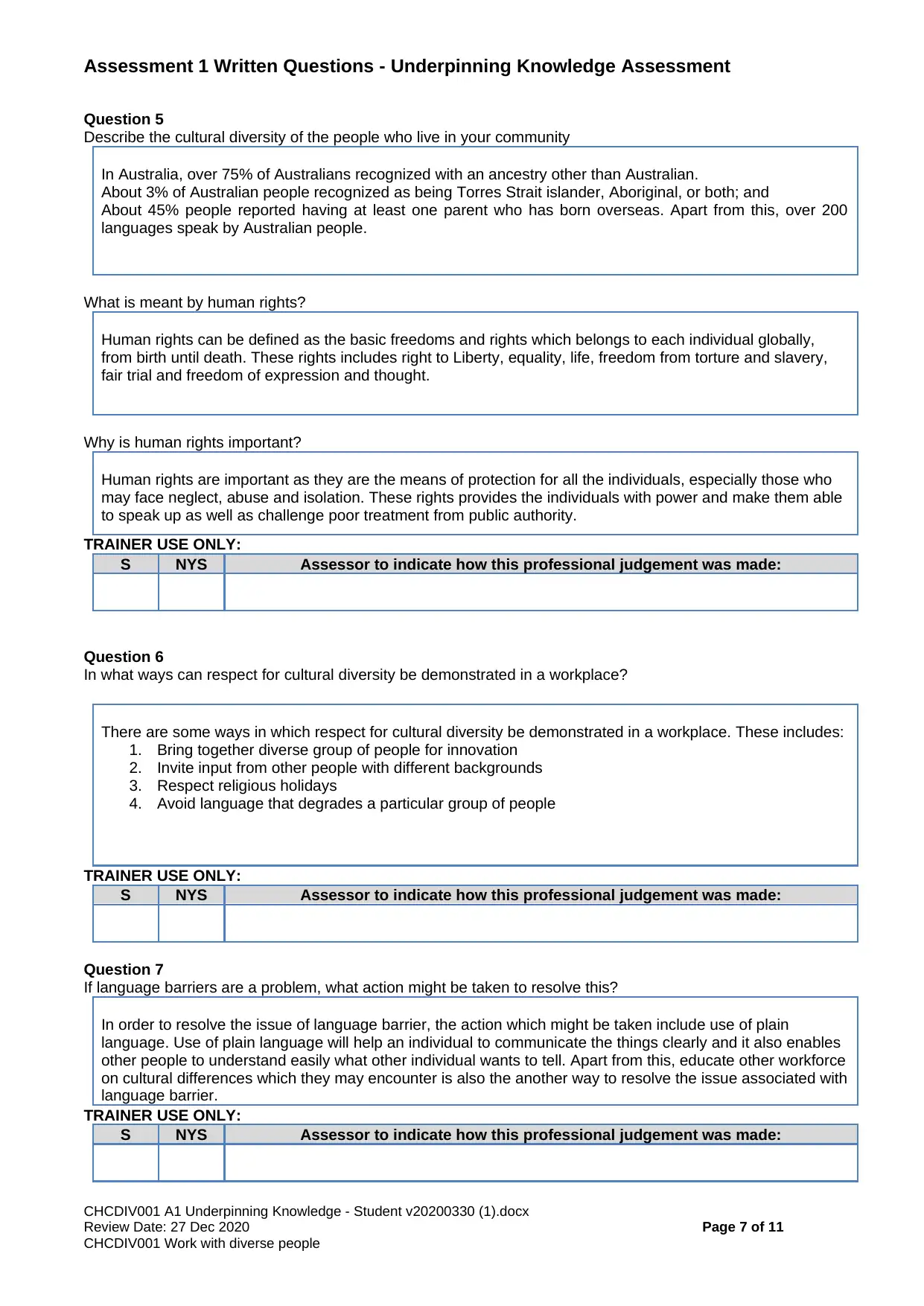
Assessment 1 Written Questions - Underpinning Knowledge Assessment
Question 5
Describe the cultural diversity of the people who live in your community
In Australia, over 75% of Australians recognized with an ancestry other than Australian.
About 3% of Australian people recognized as being Torres Strait islander, Aboriginal, or both; and
About 45% people reported having at least one parent who has born overseas. Apart from this, over 200
languages speak by Australian people.
What is meant by human rights?
Human rights can be defined as the basic freedoms and rights which belongs to each individual globally,
from birth until death. These rights includes right to Liberty, equality, life, freedom from torture and slavery,
fair trial and freedom of expression and thought.
Why is human rights important?
Human rights are important as they are the means of protection for all the individuals, especially those who
may face neglect, abuse and isolation. These rights provides the individuals with power and make them able
to speak up as well as challenge poor treatment from public authority.
TRAINER USE ONLY:
S NYS Assessor to indicate how this professional judgement was made:
Question 6
In what ways can respect for cultural diversity be demonstrated in a workplace?
There are some ways in which respect for cultural diversity be demonstrated in a workplace. These includes:
1. Bring together diverse group of people for innovation
2. Invite input from other people with different backgrounds
3. Respect religious holidays
4. Avoid language that degrades a particular group of people
TRAINER USE ONLY:
S NYS Assessor to indicate how this professional judgement was made:
Question 7
If language barriers are a problem, what action might be taken to resolve this?
In order to resolve the issue of language barrier, the action which might be taken include use of plain
language. Use of plain language will help an individual to communicate the things clearly and it also enables
other people to understand easily what other individual wants to tell. Apart from this, educate other workforce
on cultural differences which they may encounter is also the another way to resolve the issue associated with
language barrier.
TRAINER USE ONLY:
S NYS Assessor to indicate how this professional judgement was made:
CHCDIV001 A1 Underpinning Knowledge - Student v20200330 (1).docx
Review Date: 27 Dec 2020 Page 7 of 11
CHCDIV001 Work with diverse people
Question 5
Describe the cultural diversity of the people who live in your community
In Australia, over 75% of Australians recognized with an ancestry other than Australian.
About 3% of Australian people recognized as being Torres Strait islander, Aboriginal, or both; and
About 45% people reported having at least one parent who has born overseas. Apart from this, over 200
languages speak by Australian people.
What is meant by human rights?
Human rights can be defined as the basic freedoms and rights which belongs to each individual globally,
from birth until death. These rights includes right to Liberty, equality, life, freedom from torture and slavery,
fair trial and freedom of expression and thought.
Why is human rights important?
Human rights are important as they are the means of protection for all the individuals, especially those who
may face neglect, abuse and isolation. These rights provides the individuals with power and make them able
to speak up as well as challenge poor treatment from public authority.
TRAINER USE ONLY:
S NYS Assessor to indicate how this professional judgement was made:
Question 6
In what ways can respect for cultural diversity be demonstrated in a workplace?
There are some ways in which respect for cultural diversity be demonstrated in a workplace. These includes:
1. Bring together diverse group of people for innovation
2. Invite input from other people with different backgrounds
3. Respect religious holidays
4. Avoid language that degrades a particular group of people
TRAINER USE ONLY:
S NYS Assessor to indicate how this professional judgement was made:
Question 7
If language barriers are a problem, what action might be taken to resolve this?
In order to resolve the issue of language barrier, the action which might be taken include use of plain
language. Use of plain language will help an individual to communicate the things clearly and it also enables
other people to understand easily what other individual wants to tell. Apart from this, educate other workforce
on cultural differences which they may encounter is also the another way to resolve the issue associated with
language barrier.
TRAINER USE ONLY:
S NYS Assessor to indicate how this professional judgement was made:
CHCDIV001 A1 Underpinning Knowledge - Student v20200330 (1).docx
Review Date: 27 Dec 2020 Page 7 of 11
CHCDIV001 Work with diverse people
Paraphrase This Document
Need a fresh take? Get an instant paraphrase of this document with our AI Paraphraser
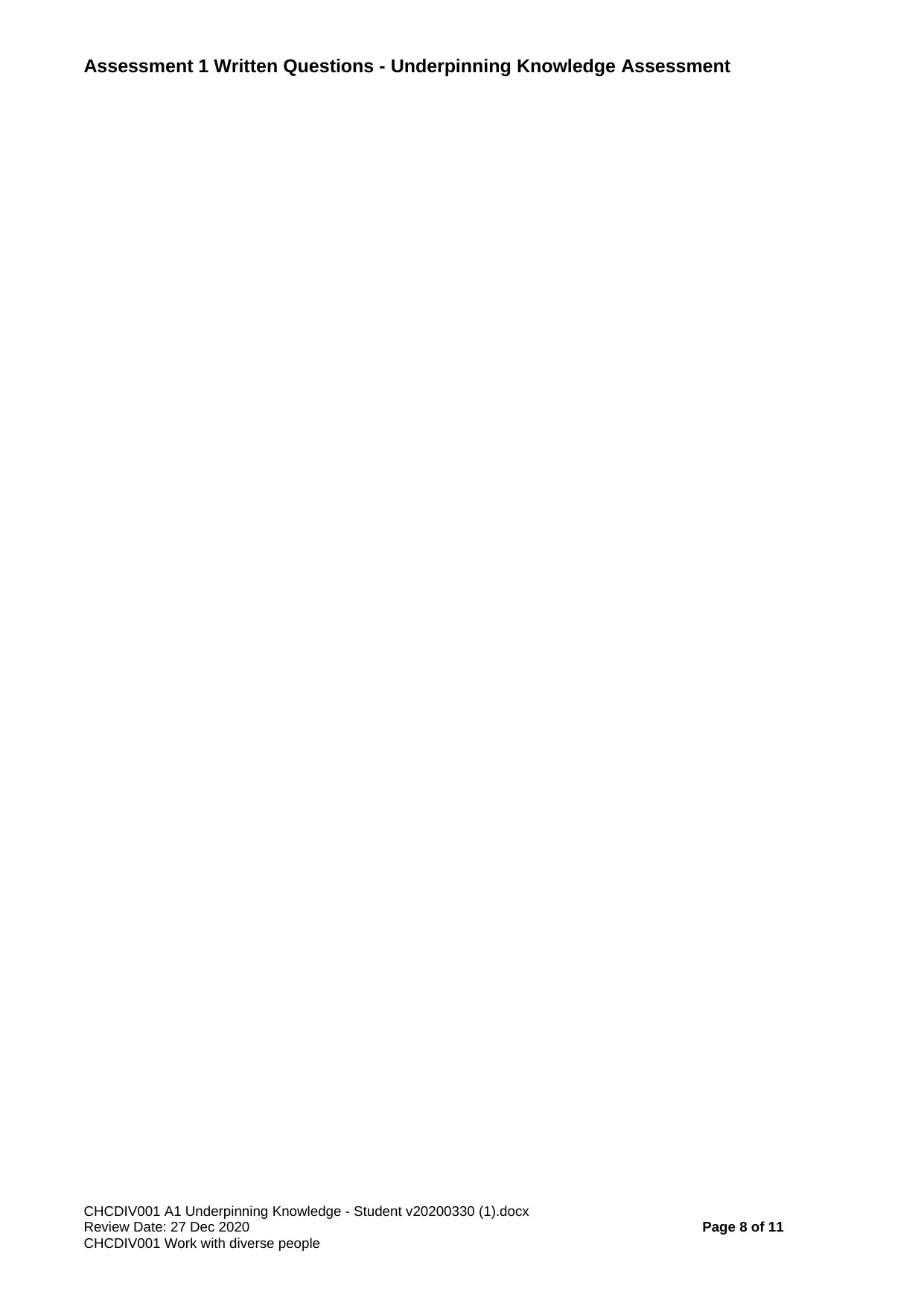
Assessment 1 Written Questions - Underpinning Knowledge Assessment
CHCDIV001 A1 Underpinning Knowledge - Student v20200330 (1).docx
Review Date: 27 Dec 2020 Page 8 of 11
CHCDIV001 Work with diverse people
CHCDIV001 A1 Underpinning Knowledge - Student v20200330 (1).docx
Review Date: 27 Dec 2020 Page 8 of 11
CHCDIV001 Work with diverse people
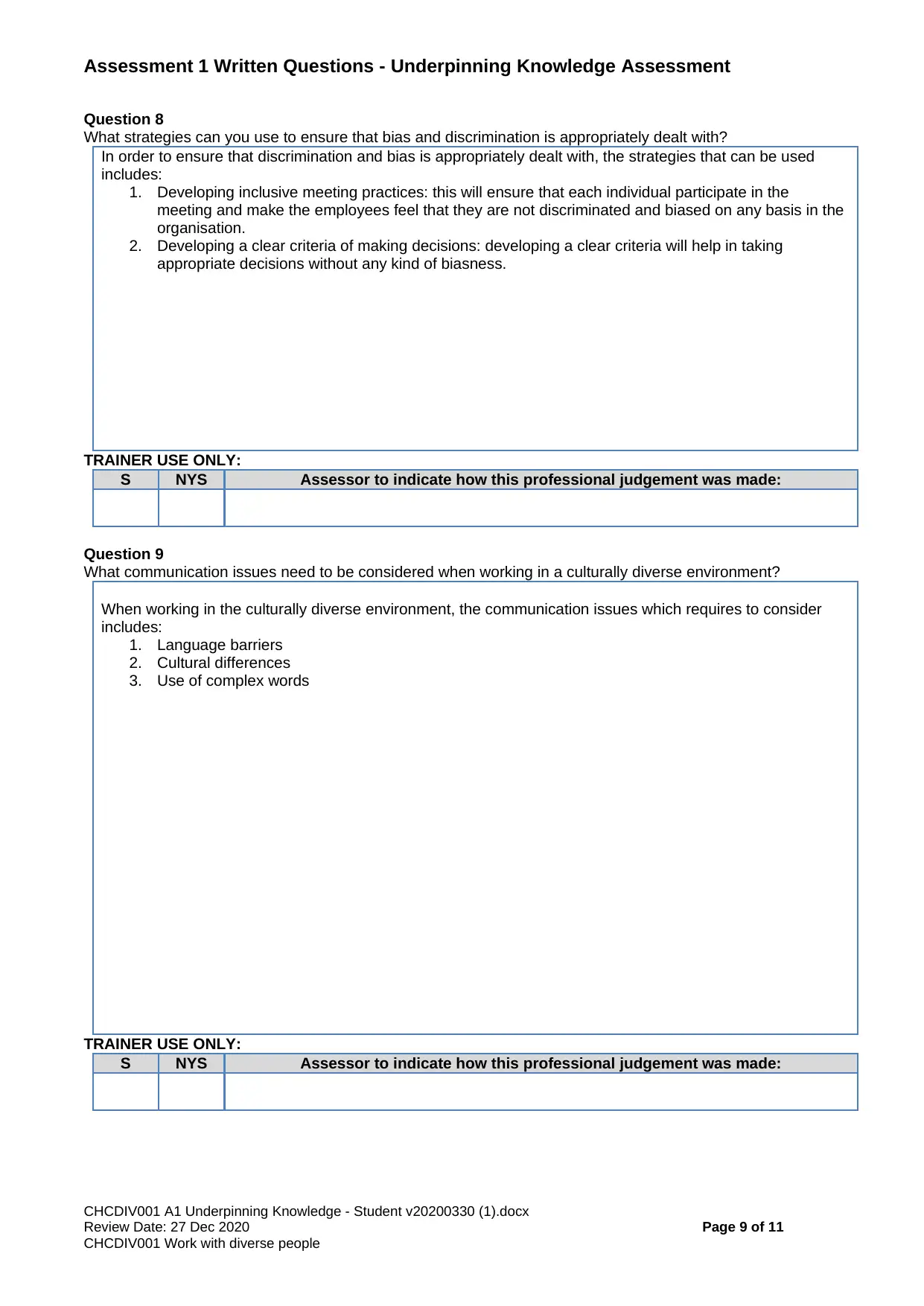
Assessment 1 Written Questions - Underpinning Knowledge Assessment
Question 8
What strategies can you use to ensure that bias and discrimination is appropriately dealt with?
In order to ensure that discrimination and bias is appropriately dealt with, the strategies that can be used
includes:
1. Developing inclusive meeting practices: this will ensure that each individual participate in the
meeting and make the employees feel that they are not discriminated and biased on any basis in the
organisation.
2. Developing a clear criteria of making decisions: developing a clear criteria will help in taking
appropriate decisions without any kind of biasness.
TRAINER USE ONLY:
S NYS Assessor to indicate how this professional judgement was made:
Question 9
What communication issues need to be considered when working in a culturally diverse environment?
When working in the culturally diverse environment, the communication issues which requires to consider
includes:
1. Language barriers
2. Cultural differences
3. Use of complex words
TRAINER USE ONLY:
S NYS Assessor to indicate how this professional judgement was made:
CHCDIV001 A1 Underpinning Knowledge - Student v20200330 (1).docx
Review Date: 27 Dec 2020 Page 9 of 11
CHCDIV001 Work with diverse people
Question 8
What strategies can you use to ensure that bias and discrimination is appropriately dealt with?
In order to ensure that discrimination and bias is appropriately dealt with, the strategies that can be used
includes:
1. Developing inclusive meeting practices: this will ensure that each individual participate in the
meeting and make the employees feel that they are not discriminated and biased on any basis in the
organisation.
2. Developing a clear criteria of making decisions: developing a clear criteria will help in taking
appropriate decisions without any kind of biasness.
TRAINER USE ONLY:
S NYS Assessor to indicate how this professional judgement was made:
Question 9
What communication issues need to be considered when working in a culturally diverse environment?
When working in the culturally diverse environment, the communication issues which requires to consider
includes:
1. Language barriers
2. Cultural differences
3. Use of complex words
TRAINER USE ONLY:
S NYS Assessor to indicate how this professional judgement was made:
CHCDIV001 A1 Underpinning Knowledge - Student v20200330 (1).docx
Review Date: 27 Dec 2020 Page 9 of 11
CHCDIV001 Work with diverse people
⊘ This is a preview!⊘
Do you want full access?
Subscribe today to unlock all pages.

Trusted by 1+ million students worldwide
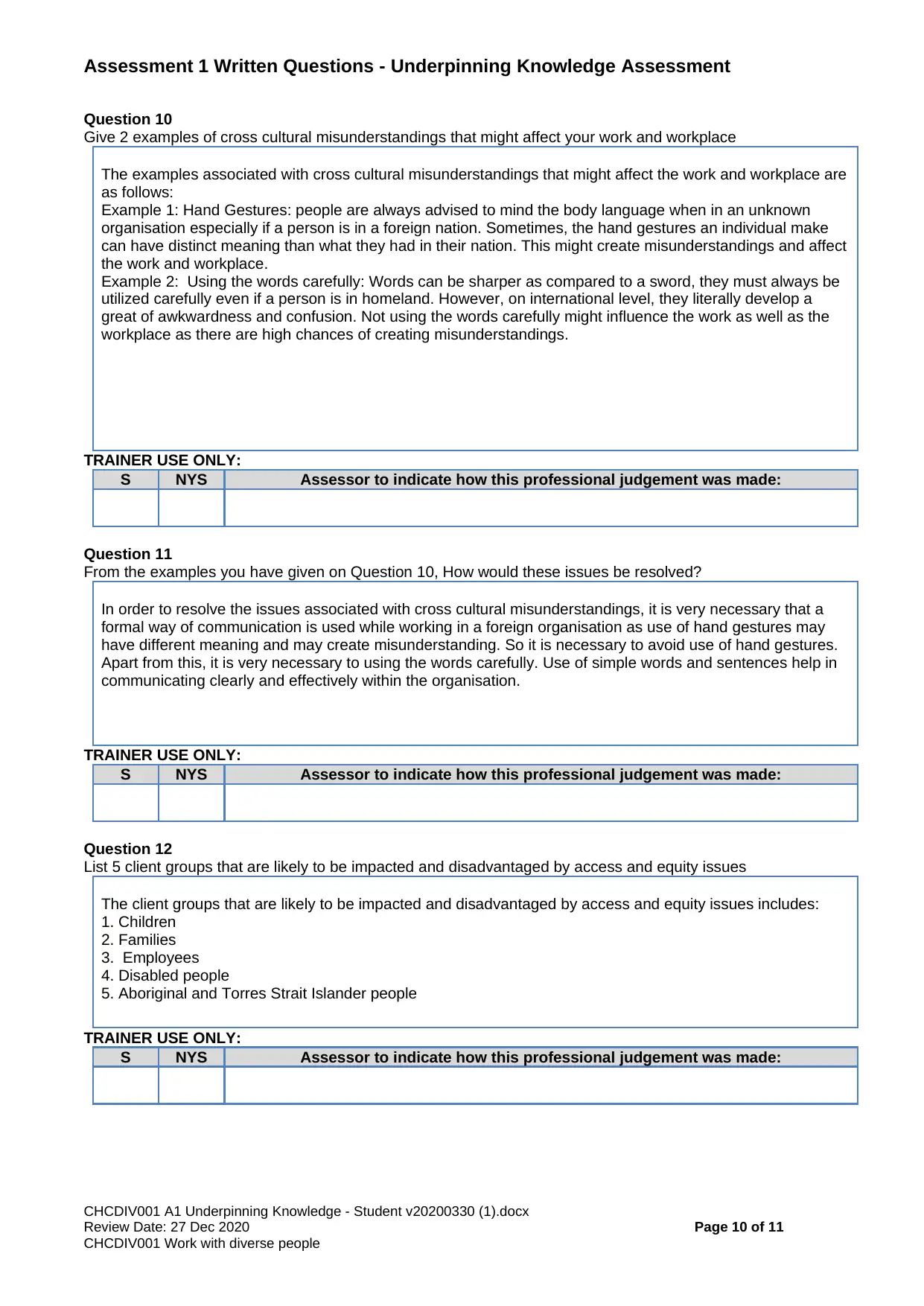
Assessment 1 Written Questions - Underpinning Knowledge Assessment
Question 10
Give 2 examples of cross cultural misunderstandings that might affect your work and workplace
The examples associated with cross cultural misunderstandings that might affect the work and workplace are
as follows:
Example 1: Hand Gestures: people are always advised to mind the body language when in an unknown
organisation especially if a person is in a foreign nation. Sometimes, the hand gestures an individual make
can have distinct meaning than what they had in their nation. This might create misunderstandings and affect
the work and workplace.
Example 2: Using the words carefully: Words can be sharper as compared to a sword, they must always be
utilized carefully even if a person is in homeland. However, on international level, they literally develop a
great of awkwardness and confusion. Not using the words carefully might influence the work as well as the
workplace as there are high chances of creating misunderstandings.
TRAINER USE ONLY:
S NYS Assessor to indicate how this professional judgement was made:
Question 11
From the examples you have given on Question 10, How would these issues be resolved?
In order to resolve the issues associated with cross cultural misunderstandings, it is very necessary that a
formal way of communication is used while working in a foreign organisation as use of hand gestures may
have different meaning and may create misunderstanding. So it is necessary to avoid use of hand gestures.
Apart from this, it is very necessary to using the words carefully. Use of simple words and sentences help in
communicating clearly and effectively within the organisation.
TRAINER USE ONLY:
S NYS Assessor to indicate how this professional judgement was made:
Question 12
List 5 client groups that are likely to be impacted and disadvantaged by access and equity issues
The client groups that are likely to be impacted and disadvantaged by access and equity issues includes:
1. Children
2. Families
3. Employees
4. Disabled people
5. Aboriginal and Torres Strait Islander people
TRAINER USE ONLY:
S NYS Assessor to indicate how this professional judgement was made:
CHCDIV001 A1 Underpinning Knowledge - Student v20200330 (1).docx
Review Date: 27 Dec 2020 Page 10 of 11
CHCDIV001 Work with diverse people
Question 10
Give 2 examples of cross cultural misunderstandings that might affect your work and workplace
The examples associated with cross cultural misunderstandings that might affect the work and workplace are
as follows:
Example 1: Hand Gestures: people are always advised to mind the body language when in an unknown
organisation especially if a person is in a foreign nation. Sometimes, the hand gestures an individual make
can have distinct meaning than what they had in their nation. This might create misunderstandings and affect
the work and workplace.
Example 2: Using the words carefully: Words can be sharper as compared to a sword, they must always be
utilized carefully even if a person is in homeland. However, on international level, they literally develop a
great of awkwardness and confusion. Not using the words carefully might influence the work as well as the
workplace as there are high chances of creating misunderstandings.
TRAINER USE ONLY:
S NYS Assessor to indicate how this professional judgement was made:
Question 11
From the examples you have given on Question 10, How would these issues be resolved?
In order to resolve the issues associated with cross cultural misunderstandings, it is very necessary that a
formal way of communication is used while working in a foreign organisation as use of hand gestures may
have different meaning and may create misunderstanding. So it is necessary to avoid use of hand gestures.
Apart from this, it is very necessary to using the words carefully. Use of simple words and sentences help in
communicating clearly and effectively within the organisation.
TRAINER USE ONLY:
S NYS Assessor to indicate how this professional judgement was made:
Question 12
List 5 client groups that are likely to be impacted and disadvantaged by access and equity issues
The client groups that are likely to be impacted and disadvantaged by access and equity issues includes:
1. Children
2. Families
3. Employees
4. Disabled people
5. Aboriginal and Torres Strait Islander people
TRAINER USE ONLY:
S NYS Assessor to indicate how this professional judgement was made:
CHCDIV001 A1 Underpinning Knowledge - Student v20200330 (1).docx
Review Date: 27 Dec 2020 Page 10 of 11
CHCDIV001 Work with diverse people
Paraphrase This Document
Need a fresh take? Get an instant paraphrase of this document with our AI Paraphraser
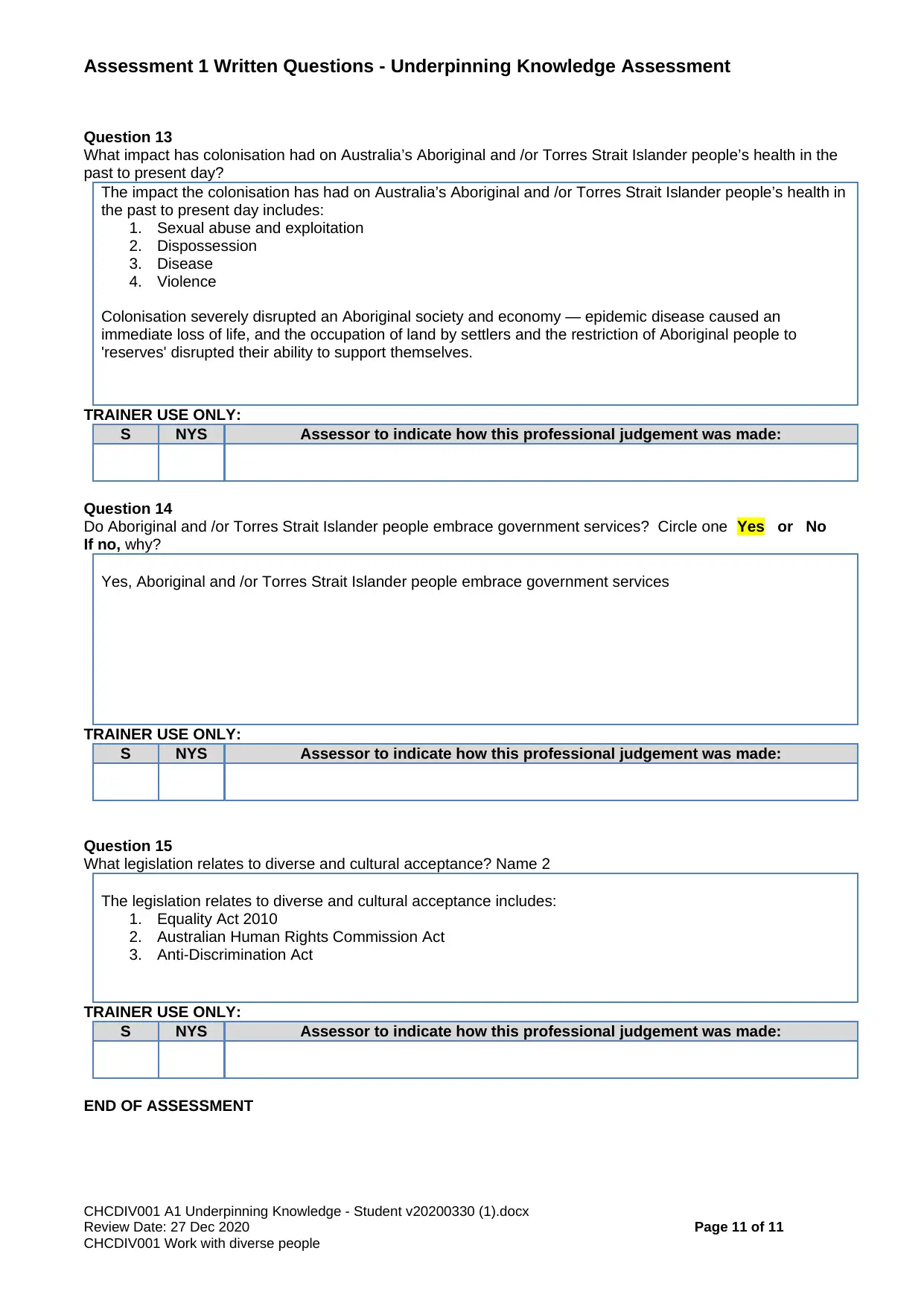
Assessment 1 Written Questions - Underpinning Knowledge Assessment
Question 13
What impact has colonisation had on Australia’s Aboriginal and /or Torres Strait Islander people’s health in the
past to present day?
The impact the colonisation has had on Australia’s Aboriginal and /or Torres Strait Islander people’s health in
the past to present day includes:
1. Sexual abuse and exploitation
2. Dispossession
3. Disease
4. Violence
Colonisation severely disrupted an Aboriginal society and economy — epidemic disease caused an
immediate loss of life, and the occupation of land by settlers and the restriction of Aboriginal people to
'reserves' disrupted their ability to support themselves.
TRAINER USE ONLY:
S NYS Assessor to indicate how this professional judgement was made:
Question 14
Do Aboriginal and /or Torres Strait Islander people embrace government services? Circle one Yes or No
If no, why?
Yes, Aboriginal and /or Torres Strait Islander people embrace government services
TRAINER USE ONLY:
S NYS Assessor to indicate how this professional judgement was made:
Question 15
What legislation relates to diverse and cultural acceptance? Name 2
The legislation relates to diverse and cultural acceptance includes:
1. Equality Act 2010
2. Australian Human Rights Commission Act
3. Anti-Discrimination Act
TRAINER USE ONLY:
S NYS Assessor to indicate how this professional judgement was made:
END OF ASSESSMENT
CHCDIV001 A1 Underpinning Knowledge - Student v20200330 (1).docx
Review Date: 27 Dec 2020 Page 11 of 11
CHCDIV001 Work with diverse people
Question 13
What impact has colonisation had on Australia’s Aboriginal and /or Torres Strait Islander people’s health in the
past to present day?
The impact the colonisation has had on Australia’s Aboriginal and /or Torres Strait Islander people’s health in
the past to present day includes:
1. Sexual abuse and exploitation
2. Dispossession
3. Disease
4. Violence
Colonisation severely disrupted an Aboriginal society and economy — epidemic disease caused an
immediate loss of life, and the occupation of land by settlers and the restriction of Aboriginal people to
'reserves' disrupted their ability to support themselves.
TRAINER USE ONLY:
S NYS Assessor to indicate how this professional judgement was made:
Question 14
Do Aboriginal and /or Torres Strait Islander people embrace government services? Circle one Yes or No
If no, why?
Yes, Aboriginal and /or Torres Strait Islander people embrace government services
TRAINER USE ONLY:
S NYS Assessor to indicate how this professional judgement was made:
Question 15
What legislation relates to diverse and cultural acceptance? Name 2
The legislation relates to diverse and cultural acceptance includes:
1. Equality Act 2010
2. Australian Human Rights Commission Act
3. Anti-Discrimination Act
TRAINER USE ONLY:
S NYS Assessor to indicate how this professional judgement was made:
END OF ASSESSMENT
CHCDIV001 A1 Underpinning Knowledge - Student v20200330 (1).docx
Review Date: 27 Dec 2020 Page 11 of 11
CHCDIV001 Work with diverse people
1 out of 11
Related Documents
Your All-in-One AI-Powered Toolkit for Academic Success.
+13062052269
info@desklib.com
Available 24*7 on WhatsApp / Email
![[object Object]](/_next/static/media/star-bottom.7253800d.svg)
Unlock your academic potential
Copyright © 2020–2025 A2Z Services. All Rights Reserved. Developed and managed by ZUCOL.





